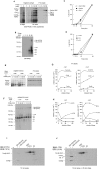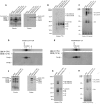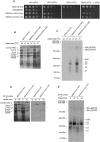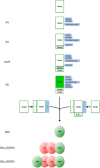Modular assembly of yeast cytochrome oxidase
- PMID: 23266989
- PMCID: PMC3571867
- DOI: 10.1091/mbc.E12-10-0749
Modular assembly of yeast cytochrome oxidase
Abstract
Previous studies of yeast cytochrome oxidase (COX) biogenesis identified Cox1p, one of the three mitochondrially encoded core subunits, in two high-molecular weight complexes combined with regulatory/assembly factors essential for expression of this subunit. In the present study we use pulse-chase labeling experiments in conjunction with isolated mitochondria to identify new Cox1p intermediates and place them in an ordered pathway. Our results indicate that before its assimilation into COX, Cox1p transitions through five intermediates that are differentiated by their compositions of accessory factors and of two of the eight imported subunits. We propose a model of COX biogenesis in which Cox1p and the two other mitochondrial gene products, Cox2p and Cox3p, constitute independent assembly modules, each with its own complement of subunits. Unlike their bacterial counterparts, which are composed only of the individual core subunits, the final sequence in which the mitochondrial modules associate to form the holoenzyme may have been conserved during evolution.
Figures







Similar articles
-
Cox2p of yeast cytochrome oxidase assembles as a stand-alone subunit with the Cox1p and Cox3p modules.J Biol Chem. 2018 Oct 26;293(43):16899-16911. doi: 10.1074/jbc.RA118.004138. Epub 2018 Sep 17. J Biol Chem. 2018. PMID: 30224355 Free PMC article.
-
Characterization of assembly intermediates containing subunit 1 of yeast cytochrome oxidase.J Biol Chem. 2013 Sep 13;288(37):26546-56. doi: 10.1074/jbc.M113.498592. Epub 2013 Jul 29. J Biol Chem. 2013. PMID: 23897805 Free PMC article.
-
Cox16 protein is physically associated with Cox1p assembly intermediates and with cytochrome oxidase.J Biol Chem. 2017 Sep 29;292(39):16277-16283. doi: 10.1074/jbc.M117.801811. Epub 2017 Aug 16. J Biol Chem. 2017. PMID: 28821616 Free PMC article.
-
Biogenesis and assembly of eukaryotic cytochrome c oxidase catalytic core.Biochim Biophys Acta. 2012 Jun;1817(6):883-97. doi: 10.1016/j.bbabio.2011.09.005. Epub 2011 Sep 16. Biochim Biophys Acta. 2012. PMID: 21958598 Free PMC article. Review.
-
Yeast cytochrome c oxidase: a model system to study mitochondrial forms of the haem-copper oxidase superfamily.Biochim Biophys Acta. 2012 Apr;1817(4):620-8. doi: 10.1016/j.bbabio.2011.08.011. Epub 2011 Sep 7. Biochim Biophys Acta. 2012. PMID: 21925484 Free PMC article. Review.
Cited by
-
Mitochondrial versus nuclear gene expression and membrane protein assembly: the case of subunit 2 of yeast cytochrome c oxidase.Mol Biol Cell. 2018 Apr 1;29(7):820-833. doi: 10.1091/mbc.E17-09-0560. Mol Biol Cell. 2018. PMID: 29437907 Free PMC article.
-
Assembly of the rotor component of yeast mitochondrial ATP synthase is enhanced when Atp9p is supplied by Atp9p-Cox6p complexes.J Biol Chem. 2014 Nov 7;289(45):31605-16. doi: 10.1074/jbc.M114.602706. Epub 2014 Sep 24. J Biol Chem. 2014. PMID: 25253699 Free PMC article.
-
Mitochondrial Cytochrome c Oxidase Biogenesis Is Regulated by the Redox State of a Heme-Binding Translational Activator.Antioxid Redox Signal. 2016 Feb 20;24(6):281-98. doi: 10.1089/ars.2015.6429. Epub 2015 Nov 2. Antioxid Redox Signal. 2016. PMID: 26415097 Free PMC article.
-
Mitochondrial cytochrome c oxidase biogenesis: Recent developments.Semin Cell Dev Biol. 2018 Apr;76:163-178. doi: 10.1016/j.semcdb.2017.08.055. Epub 2017 Sep 8. Semin Cell Dev Biol. 2018. PMID: 28870773 Free PMC article. Review.
-
Cardiomyopathy-associated mutation in the ADP/ATP carrier reveals translation-dependent regulation of cytochrome c oxidase activity.Mol Biol Cell. 2018 Jun 15;29(12):1449-1464. doi: 10.1091/mbc.E17-12-0700. Epub 2018 Apr 24. Mol Biol Cell. 2018. PMID: 29688796 Free PMC article.
References
-
- Carr HS, Winge DR. Assembly of cytochrome c oxidase within the mitochondrion. Acc Chem Res. 2003;36:309–316. - PubMed
-
- Choquet Y, Wostrikoff K, Rimbault B, Zito F, Girard-Bascou J, Drapier D, Wollman FA. Assembly-controlled regulation of chloroplast gene translation. Biochem Soc Trans. 2001;29:421–426. - PubMed
Publication types
MeSH terms
Substances
Grants and funding
LinkOut - more resources
Full Text Sources
Other Literature Sources
Molecular Biology Databases

